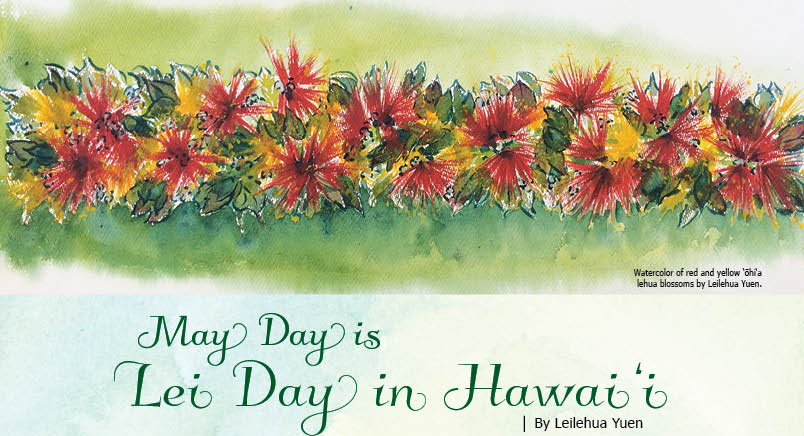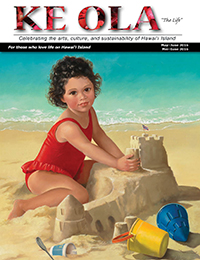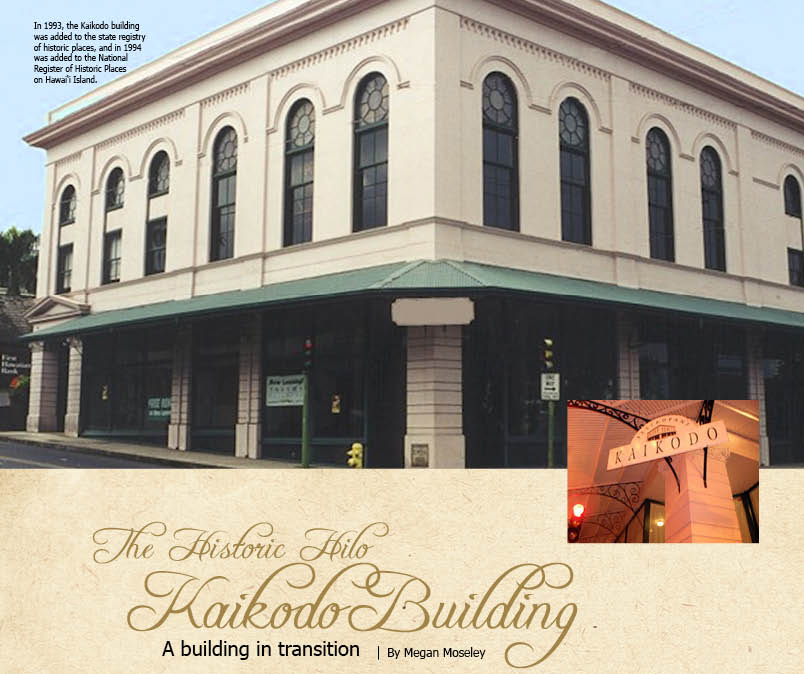
May Day is Lei Day in Hawai‘i
By Leilehua Yuen
May 1, celebrated around the world as a workers’ holiday, and in England and parts of Europe as a festival of spring, in the Hawaiian Islands has been known for some four generations as Lei Day.
Don Blanding, fondly known as the “Poet Laureate of Hawai‘i,” explained the origin of the Hawaiian holiday in his book, Hula Moons, thus: “Along in the latter part of 1927 I had an idea; not that that gave me a headache, but it seemed such a good one that I had to tell some one about it, so I told the editors of the Honolulu Star-Bulletin, the paper on which I worked. They agreed that it was a good idea and that we ought to present it to the public, which we proceeded to do. It took hold at once and resulted in something decidedly beautiful.
“…The custom of weaving and wearing flower leis originated with the Hawaiians so long ago that they have no record of its beginning…When tourists discovered Hawaii, they loved the charming gesture and they spread the word of it until the lei became known around the world.”
“…Hawaii observed all of the mainland holidays as well as those of a number of the immigrant nationalities in the Islands. But there was no day that was peculiarly and completely Hawaii’s own; that is none that included all of the polyglot population there.”
“So, the bright idea that I presented was, ‘Why not have a Lei Day?’ Let everyone wear a lei and give a lei. Let it be a day of general rejoicing over the fact that one lived in a Paradise. Let it be a day for remembering old friends, renewing neglected contacts, with the slogan ‘Aloha,’ allowing that flexible word to mean friendliness on that day.”
Don proposed the holiday in his column in the Honolulu Star-Bulletin on February 13, 1928. Two days later the paper printed a letter from Don’s co-worker, columnist Grace Tower Warren, who suggested May 1st May Day celebrations as ideal for the holiday, and crafted the slogan, “May Day is Lei Day in Hawaii.”
Princess Helen Kawananākoa told Don, “Indeed, I do approve of the idea. I think it is a beautiful thought and you may count on me for anything you want to help it along. And I know that you will have the loyal support of all the Hawaiians on O‘ahu. They have been discussing it among themselves and are unanimously in favor of it. The nicest part of Lei Day is that it brings kamaainas together again. With so many malihinis and malihini customs in Honolulu, the old-timers have rather withdrawn from public events. Lei Day is so much in the old-time manner that they are planning to revive many ‘good old days’ courtesies.”

In 1929, Lei Day received official recognition, and continues to be marked by celebrations ranging from simple giving and receiving of lei between family and friends, to sponsored competitions, to the world-renowned Lei Day show put on each year by the Brothers Cazimero. This yearʻs event is on Maui.
In 2001, Hawai‘i Senator Daniel Kahikina Akaka, during a May 1 address said, “ ‘May Day is Lei Day’ in Hawai‘i. Lei Day is a nonpolitical and nonpartisan celebration. Indeed, its sole purpose is to engage in random acts of kindness and sharing, and to celebrate the Aloha spirit, that intangible, but palpable, essence which is best exemplified by the hospitality and inclusiveness exhibited by the Native Hawaiians—Hawai‘i’s indigenous peoples—to all people of goodwill.”
Lei are an instantly recognizable symbol of Hawai‘i. The wreaths of flowers and foliage worn by both men and women add fragrance and beauty to island life.
As Princess Kawananākoa explained to Don those many years ago, a lei is more than a garland of flowers hastily bought and carelessly given. She said that it should be made by the giver with much thought and consideration of color combination, fragrance, and design.
Lei also are more than flowers sewn on a strand. There are lei of seeds, shells, feathers, and even words. A special song composed for a loved one can be a lei. All of them are a tangible expression of aloha, and as such are given to show love, joy, or sympathy, and as greetings and farewells. In fact, poetically, a child is called a lei, because the child is the weaving together of the love of his or her parents and ancestors.
Historian and writer Emma Ahuena Taylor wrote in 1928, “The lei meant a great deal in old Hawai‘i. The favorite child in the home was called a wreath—a lei. Konia, the mother of Bernice Pauahi Bishop, when she spoke of Lili‘uokalani, called her the ‘lei a‘i,’ or ‘the wreath of her neck.’ As to Princess Pauahi, her daughter, she spoke of her as her ‘lei po‘o,’ or ‘the wreath of her head.’ This has been told me by my mother.”
For millennia, Hawaiian poetry has celebrated the lei from ancient chants to modern songs, from poetic metaphors to literal descriptions, the lei has been a popular subject. This fascination with the lei continues today, and even engendered a holiday, Lei Day, to celebrate this delightful part of Hawaiian culture.
Today, the song most associated with Lei Day was written by Carol Colombe and Leonard “Red” Hawk. In it Don Blanding and Grace Warren were popularizing Don’s idea to create a holiday to celebrate the lei. Grace’s catchphrase, “May Day is Lei Day in Hawai‘i,” became the “hook” of the new song. Today, only the chorus is generally performed, though Carol and Leonard had actually written a chorus and two verses. Though this hapa-haole mele (Hawaiian song with English words) is generally performed as a hula, originally it was a fox-trot!
A Traditional Lei Chant
| Ke lei maila o Ka‘ula o ke kai Ka mālamalama o Ni‘ihau ua mālie A mālie pā ka Inuwai Ke inu maila nā hala o Naue i ke kai No Naue kahala, no Puna ka wahine No ka lua nō I Kīlauea Ua ‘ikea |
A lei of sea foam is there at Ka‘ula Ni‘ihau shines in the calm Parched by the Inuwai wind There drink the pandanus of Naue from the sea From Naue the pandanus, from Puna the woman From the pit indeed of the Volcano Let it be known |
In modern times, a lei is often given with a kiss. The story goes: During World War II, a hula dancer at one of the USO clubs was dared by her girlfriends to kiss a handsome young officer. She met the challenge by going up to him and giving him her lei, saying, “It is our custom to give a kiss with a lei.” Thus a new “ancient” custom was born.
Formerly, while the lei was always given with great affection and respect, it might not always be placed on the recipient by the giver. To “na po‘e kahiko,” the people of olden times, the head was sacred. People did not put their hands or arms above another’s head. A lei was carefully wrapped in a special container, often made of fresh ti leaves, and handed to the recipient. If the lei was for a very high ranking ali‘i, then the lei would be handed to a retainer to give the ali‘i.
Taylor wrote, “Leis, I have always known, were, and are, an expression of love. Leis were the garments of Hiku, the god of love. When one arrives at a Hawaiian home, the dwellers therein always hasten to deck him with leis, their expression of welcome and love. At departure, that same expression—of love—and farewell, is used in leis to decorate the departing one.
“At a feast, it is not complete unless every guest is bedecked with a lei. In olden times when people were traveling and they came to a sacred or historic place where there might be a stone that was venerated, the visitors placed wreaths of greenery upon it. . .
“It seems to me that anything that tends to perpetuate the beautiful custom of the lei is worthwhile. What is more beautiful and fragrant than the green maile of different varieties, as one of the standard lei of Hawaii. ‘Lei Day’ and ‘May Day’ almost seem synonymous.”
May Day is Lei Day in Hawai‘i
Words by Carol Colombe, music by Leonard “Red” Hawk
Land of the flowers, of flow’ry bowers,
In her gay dress she appears
A sweet happy maid, may her dress never fade
As she carries this day through the years
May Day is Lei Day in Hawai‘i
Garlands of flowers ev’ry where
All of the colors in the rainbow
Maidens with blossoms in their hair
Flowers that mean we should be happy
Throwing aside our load of care, Oh!
May Day is Lei Day in Hawai‘i
Lei Day is happy day out there.
Land of green mountains, gardens and fountains
Beaches of white shining sand
Where each one I see has a smile just for me
And has ready a welcoming hand
May Day is Lei Day in Hawai‘i
Garlands of flowers ev’ry where
All of the colors in the rainbow
Maidens with blossoms in their hair
Flowers that mean we should be happy
Throwing aside our load of care, Oh!
May Day is Lei Day in Hawai‘i
Lei Day is happy day out there.
Among the many supporters of Lei Day were tourism officials and business people. Along with Don, they saw huge commercial potential in the holiday. Warren and others who saw themselves more as North American expatriates living in the islands thought of the new holiday as a way to enjoy their own traditions with a tropical flavor.
To Hawaiians, it was a way to regain and promote their mother culture, which they saw washing out to sea in the tsunami of modernization and Americanization.
Kama‘āina Gerrit Wilder probably put the feeling of ‘locals’ most succinctly when he wrote in April 1928, “I heartily kōkua for ‘More Hawai‘i in Hawai‘i.’ ” ❖
Contact writer Leilehua Yuen
Bibliography
Beyond Primitivism: Indigenous Religious Traditions and Modernity, edited by Jacob Kẹhinde Olupona
My Glass Duchess



